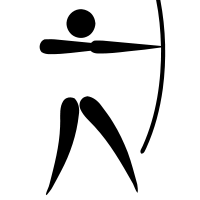ARW2
| Sport | Paralympic Archery |
|---|---|
| Administrator | International Archery Federation |
ARW2 is a Paralympic archery classification.
History
A version of this classification first appeared in 1998 during the World Championships, when the sport's governing body decided to pilot a classification programme. At the time, there was a classification called W1, which was for all sitting archers.[1]
Sport
This is a Paralympic archery classification.[2] In 2000, BBC Sport defined this classification as "W2, wheelchair users with full arm function. "[3] In 2008, BBC Sport defined this classification was "ARW2: wheelchair users with full arm function"[2] In 2008, the Australian Broadcasting Corporation defined this classification was "The main difference between ARW1 and ARW2 is the amount of functional ability athletes have in their upper bodies.".[4] In 2012, the Australian Paralympic Education Programme defined this classification as "ARW2 - wheelchair users with full arm movement"[5] In 2010, World Archery defined this classification as: "Defined as paraplegic archer in a wheelchair or comparable disability."[6] The Telegraph in 2011 described this classification as: "Athletes shooting from wheelchairs, but whose disability have less impact than W1 "[7] The British Council defines this classification in 2012 as: "These athletes have a disability that affects only their legs."[8]
Events
At the 2008 Summer Paralympics, this classification was known as W2. Events eligible for this classification included W2 Men, W1/2 Women, and team. For the W2 Men, archers qualified from China, Chinese Taipei, France, Germany, Great Britain, Israel, Italy, Japan, Korea, Malaysia, the Netherlands, Poland, Slovakia, Spain, Thailand, Turkey, the Ukreain and the United States. For the W1/2 Women's competition, archers qualified from Canada, China, the Czech Republic, France, Germany, Great Britain, Italy, Japan, Turkey and the Ukraine.[9]
The World Archery Para Championships are the major international event for this classification. In 2011, it was held in Turin, Italy and served as a qualification competition for the 2012 Summer Paralympics. Events for this classification included Individual Recurve Men W2 and Individual Recurve Women W2, in addition to team events using either a compound bow or a recurve bow.[10]
At the 2011 BWAA & WheelPower National Championships & 7th Invitational Event held at the Stoke Mandeville Stadium in England, the gold medal in the Recurve Bow Class W2 Men event was won by Mustafa Demit of Turkey, the silver by Taras Chopyk of the Ukraine and the bronze by Piotr Sawicki of Poland. In the Recurve Bow Class W2 Women event, gold was won by Gizem Girismen of Turkey, silver by Hatice Bayer of Turkey and bronze by Ozlem Kalay of Turkey.[11]
For the 2012 Summer Paralympics, the men's individual recurve qualifying score for the event set by FITA and the International Paralympic Committee was 1100+ FITA score and 720 Round Score of 550+.[12]
For the 2012 Summer Paralympics, the women's individual recurve qualifying score for the event set by FITA and the International Paralympic Committee was 1000+ FITA score and 720 Round Score of 450+.[12]
At the 2012 Paralympics, this classification will compete in the "Olympic round format at a 122cm target from a distance of 70m".[13]
Equipment
For archers in this class, "no part of the chair back or its vertical support may protrude in front of the half of the trunk." Their wheelchair can be higher than 110 millimetres (4.3 in) from the bottom of the armpit of an archer.[6]
Competitors
Competitors from this classification include Canada’s Lyne Tremblay.[10]
Becoming classified
Classification is handled by FITA – International Archery Federation.[14] FITA has an Ad Hoc Committee dedication to classification, which is led by Chief Classifier Pauline Betteridge. This committee is in charge of determining classifications, providing materials about classifications and training people to classify archers.[15]
World Archery classification is done by at least three people. One of them must have a medical background. On the national level, there only needs to be one classifier.[6]
Archery classification is done by medical professionals. In classifying an archer, the classifiers look for the range of movement and strength of the archer's arms, legs and back.[15]
See also
References
- ↑ "History of Para-Archery". FITA Para-Archery Committee. Retrieved 9 April 2012.
- ↑ 2.0 2.1 "A-Z of Paralympic classification". BBC Sport. 28 August 2008. Retrieved 9 April 2012.
- ↑ "Making sense of the categories". United Kingdom: BBC Sports. 6 October 2000. Retrieved 9 April 2012.
- ↑ McGarry, Andrew (3 September 2008). "Paralympics categories explained". Australian Broadcasting Corporation. Retrieved 9 April 2012.
- ↑ "Archery". Australia: Paralympic Education Program. 2012. Retrieved 12 April 2012.
- ↑ 6.0 6.1 6.2 "FITA Para-Archery, A Handbook for Classifiers". World Archery. 2010. Retrieved 11 June 2012.
- ↑ "London 2012 Paralympics: Archery guide". London: The Telegraph. 26 August 2011. Retrieved 11 June 2012.
- ↑ "Paralympic Archery". British Council. 2012. Retrieved 11 June 2012.
- ↑ "Paralympic Games 2008 - Beijing (CHN), Qualification Slots". FITA. 2008. Retrieved 12 April 2012.
- ↑ 10.0 10.1 "World Para Archery Championships Gets Starts in Turin". International Paralympic Committee. 2011. Retrieved 12 April 2012.
- ↑ "BWAA & WheelPower National Championships & 7th Invitational Event". England: British Wheelchair Archery ASsociation. 18 June 2011. Retrieved 12 April 2012.
- ↑ 12.0 12.1 Weiss, Katrina (April 2012). "2012 U.S. Paralympic Team Trials for Archery". United States Paralympics Team. Retrieved 11 June 2012.
- ↑ "Guide to the Paralympic Games – Sport by sport guide". London Organising Committee of the Olympic and Paralympic Games. 2011. p. 29. Retrieved 9 April 2012.
- ↑ "Guide to the Paralympic Games – Appendix 1". London Organising Committee of the Olympic and Paralympic Games. 2011. p. 42. Retrieved 9 April 2012.
- ↑ 15.0 15.1 "Para-Archery Classification". FITA Para-Archery Committee. Retrieved 9 March 2012.
External links
| Wikimedia Commons has media related to Archery at the Paralympics. |
| ||||||||||||||||||||||||||||||||||
| ||||||||
| ||||||||

.svg.png)